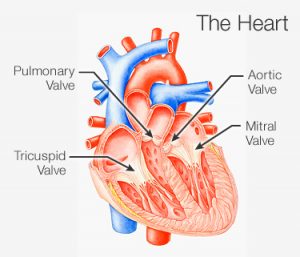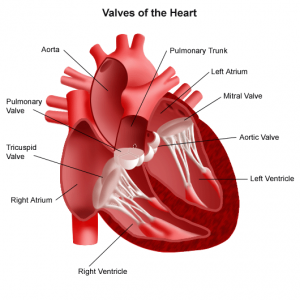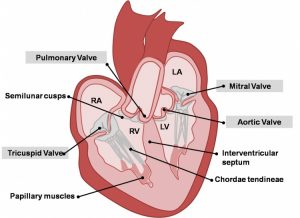What is the Tricuspid Valve?
The tricuspid valve is one of the main values which is present in the mammalian heart. It is situated on the right, dorsal side of the heart, and it is situated between the right atrium and the right ventricle. The tricuspid valve is made up of three flaps which open and close. The function of this value is to allow the blood to flow from the right atrium to the right ventricle of our hearts. It also prevents the blood from flowing backward, thus causing any further issues. It can also be seen in some cases that the tricuspid valve consists of two or even four flaps instead of three.
The tricuspid valve literally refers to three cusps or flaps which the valve consists of. In some individuals, it can also be found that the tricuspid valve is consisting of 2, or even 4 flaps instead of the usual 3 flaps.
Characteristics of Tricuspid Valve
The tricuspid valve is like a barrier wall between the right atrium and the right ventricle. The word tricuspid literally refers to the way the valve is constructed; the tricuspid valve is constructed of three cusps or flaps, which keep the blood from flowing backward into the right atrium, and also which allow deoxygenated blood to flow from the right atrium into the right ventricle of the hearts of mammals. The tricuspid valve is also referred to as the right atrioventricular valve complex.
In case of diseases or deformations, the regression of blood takes place when the tricuspid valve is not able to perform its functions properly.
Location of the Tricuspid Valve
The tricuspid valve is located in between the right atrium and the right ventricle and is approximately 4 to 6 cm² in size. The position of the tricuspid valve is almost completely vertical but is tilted towards a 45-degree angle. The tricuspid valve is located close to the apex, and a little further away from the mitral valve.
Origin of the Tricuspid Valve
The tricuspid valve is one of the four valves of the heart. It originates from the right atrium, where it collects deoxygenated blood from, and then extends on to the right ventricle, where this blood is carried via the tricuspid valve. The tricuspid valve is 4 to 6 cm sq in size and stands in an almost vertical position with a slight 45-degree angle position from the sagittal plane.
Structure of the Tricuspid Valve
The tricuspid valve is one of the two main valves which are present on the right side of the mammalian heart. The tricuspid valve, as the name suggests, typically should consist of three flaps or openings, which transport the blood from the right atrium into the right ventricle, for further transportation. In a healthy tricuspid valve, the flaps also prevent the backflow of this deoxygenated blood from the valve back into the right atrium.
The tricuspid valve also consists of three papillaries. These papillary muscles are connected to the three flaps of the tricuspid valve by the chordae tendinea.
The three cusps or flaps of the tricuspid valve are known as the:
• Anterior (A)
• Septal (S)
• Posterior (P)
Anatomy of the Tricuspid Valve
The tricuspid valve has an area of 4 to 6 cm square and is located between the right atrium and the right ventricle of the heart. The tricuspid valve consists of three flaps or leaflets, however, cases are found when the tricuspid valve consists of only two, or even four leaflets instead of the traditional three.
The position of the tricuspid valve is almost completely vertical, where it lies at a 45-degree angle from the sagittal plane.
The anterior leaflet or flap of the tricuspid valve is also often referred to as the Superior and is the largest leaflet, while the posterior flap or leaflet of the tricuspid valve is referred to as inferior and is the smallest leaflet. The septal leaflet is the second largest leaflet of the tricuspid valve.
A fibrous structure called the annulus is a firm, supporting structure that holds the tricuspid valve. It also divides or provides a boundary between the right atrium and the right ventricle.
Function of the Tricuspid Valve
The tricuspid valve performs two main functions:
1. When the tricuspid valve opens up during ventricular diastole, the deoxygenated blood which flows from the right atrium to the right ventricle flows through the tricuspid valve in the middle.
2. During ventricular systole, the tricuspid valve closes, thus not allowing the same deoxygenated blood to flow backward, back into the right atrium.
In a healthy functioning heart, both of these functions are performed harmoniously. However, in a diseased heart or a heart with certain disorders, this deoxygenated blood can often flow back into the right atrium and back into the heart, causing a lot of issues.
Tricuspid Valve Pictures
Related conditions and clinical complications of the Tricuspid Valve
One of the clinical complications relating to the tricuspid valve is known as Tricuspid Valve Disease.
This refers to the disorder when the tricuspid valve does not function properly, and the function of allowing deoxygenated blood from the right atrium to the right ventricle is not properly executed. The tricuspid valve might be too narrow in some cases, not allowing enough deoxygenated blood to flow from the right atrium into the right ventricle.
Another case might occur when the tricuspid valve does not shut properly during ventricular systole. This means that the deoxygenated blood flows back into the right atrium. This condition is known as regurgitation.
Causes of Tricuspid Valve disease
• One of the causes of tricuspid valve disease can be accounted due to age-related factors.
• Another disease related to the tricuspid valve is known as tricuspid valve stenosis. In this condition, the tricuspid valve becomes inflamed due to the effects of strep infections such as rheumatic fever.
• Tricuspid valve regurgitation is a condition when the flaps of the tricuspid valve do not close tightly, thus causing deoxygenated blood to flow back from the valve into the right atrium. This is caused due to infection, which causes the flaps of the tricuspid valve to get destroyed. Certain diseases can also cause the right ventricle to become enlarged. This pulls on the tricuspid valve and causes it to tear.
• Heart failure or high blood pressure may also cause enlargement of the tricuspid valve, causing them to not function properly.
• Intravenous drug users may also get infected, which can cause endocarditis and problems relating to the tricuspid valve.
Treatment methods
- Tricuspid valve disease cannot be diagnosed on its own, however, a series of other tests may conclude that an individual might be having a condition or diseases relating to the tricuspid valve.
- Sometimes, a tricuspid valve condition does not cause much effects or conditions, or might even cause some mild conditions. These conditions can be left untreated, or be treated with medication.
- However, when the symptoms are more dangerous, surgery might be required for the treatment of faulty tricuspid valves. Tricuspid valve replacement surgery can also be performed on a patient when their tricuspid valve is beyond repair, and they might need a new one.




No comments yet.